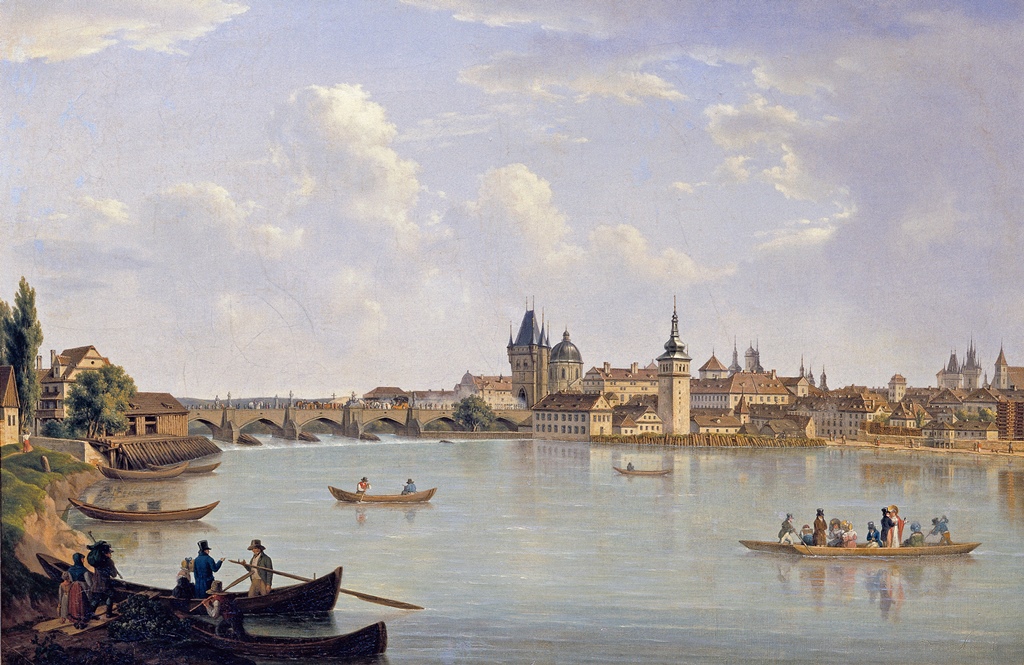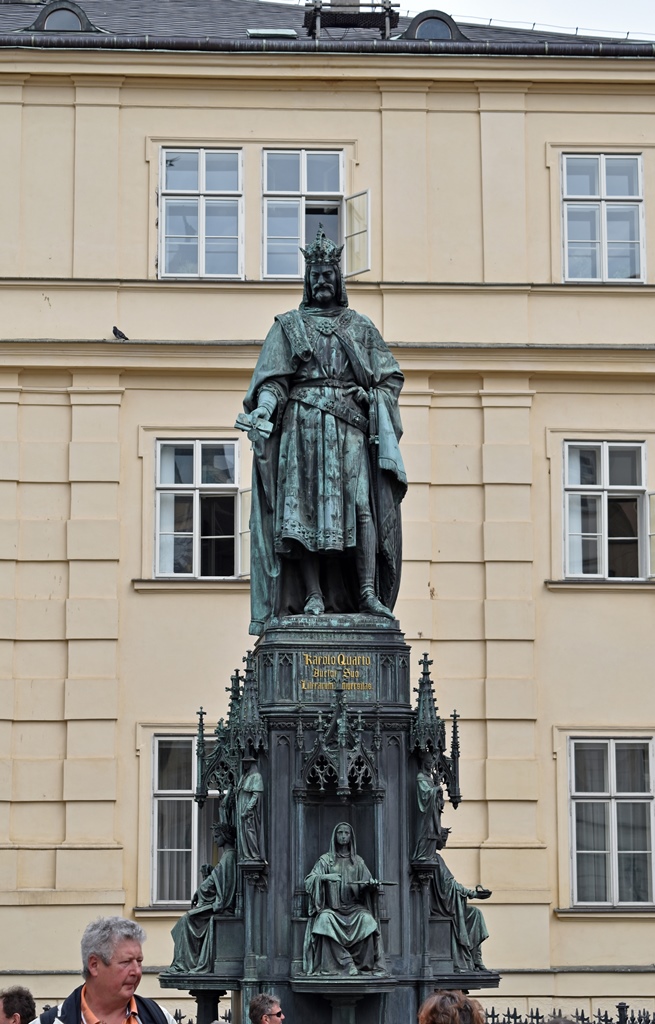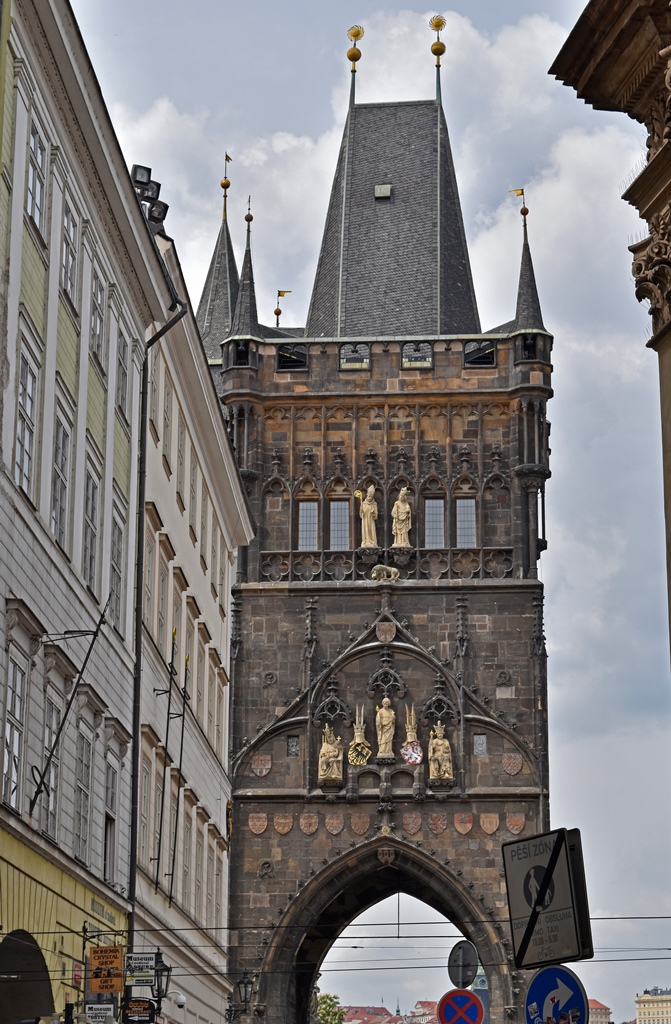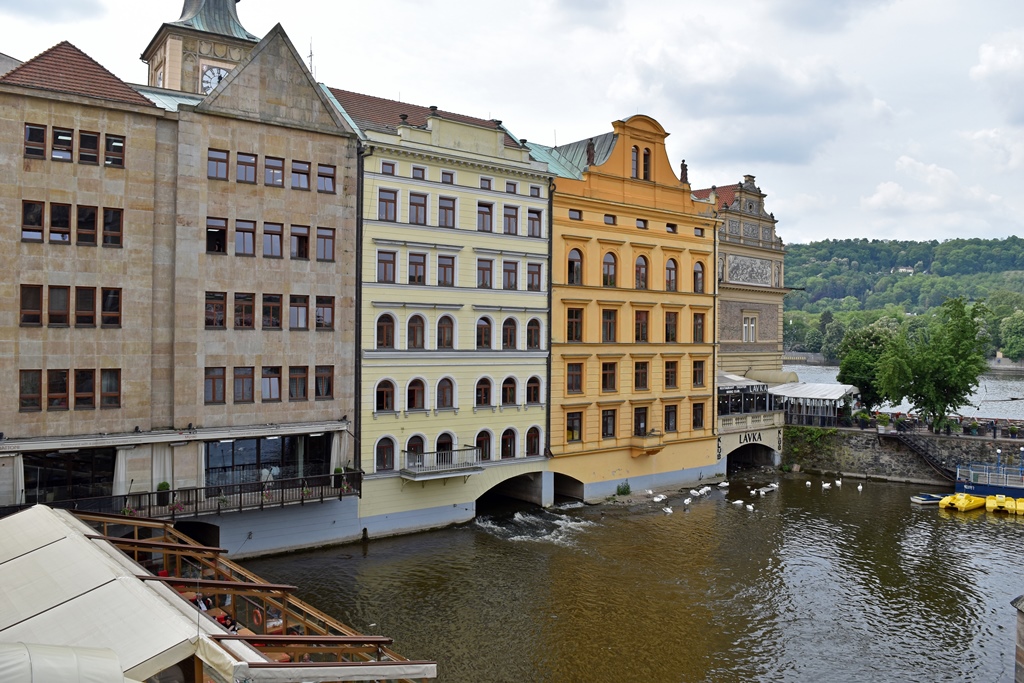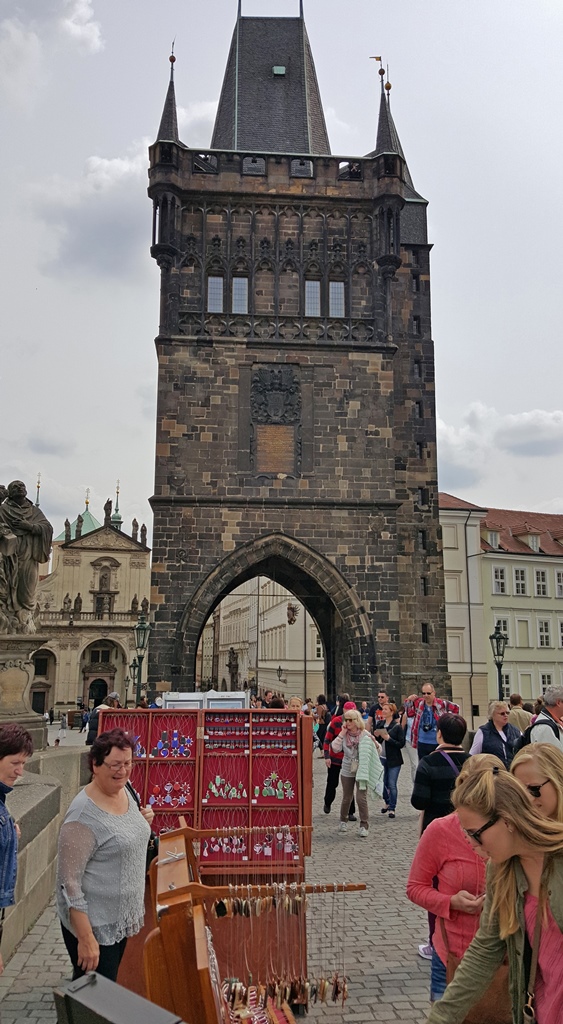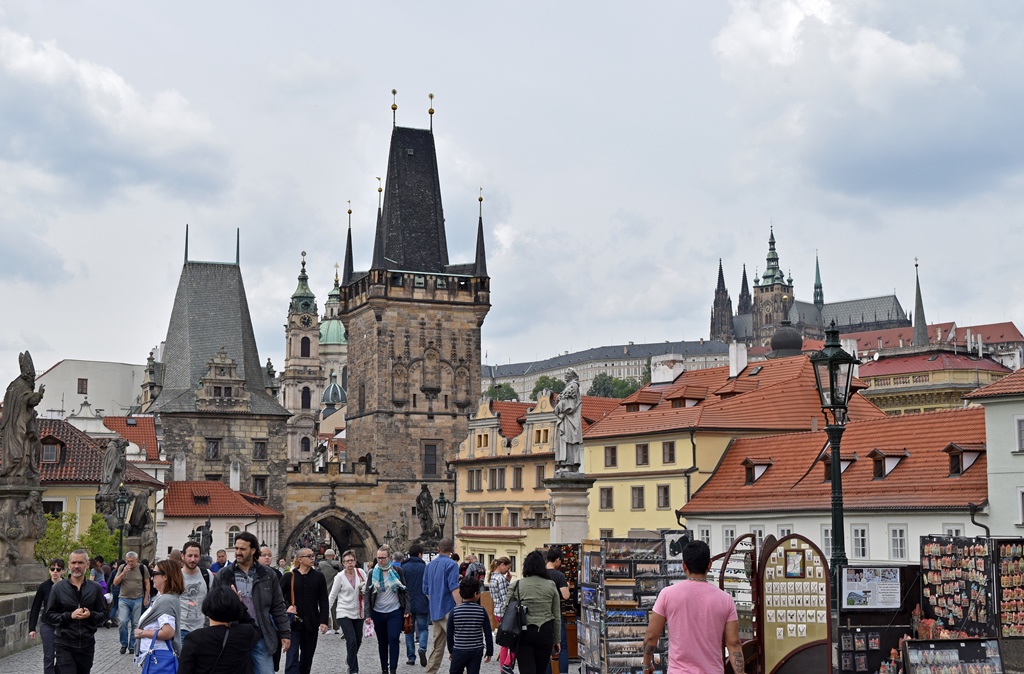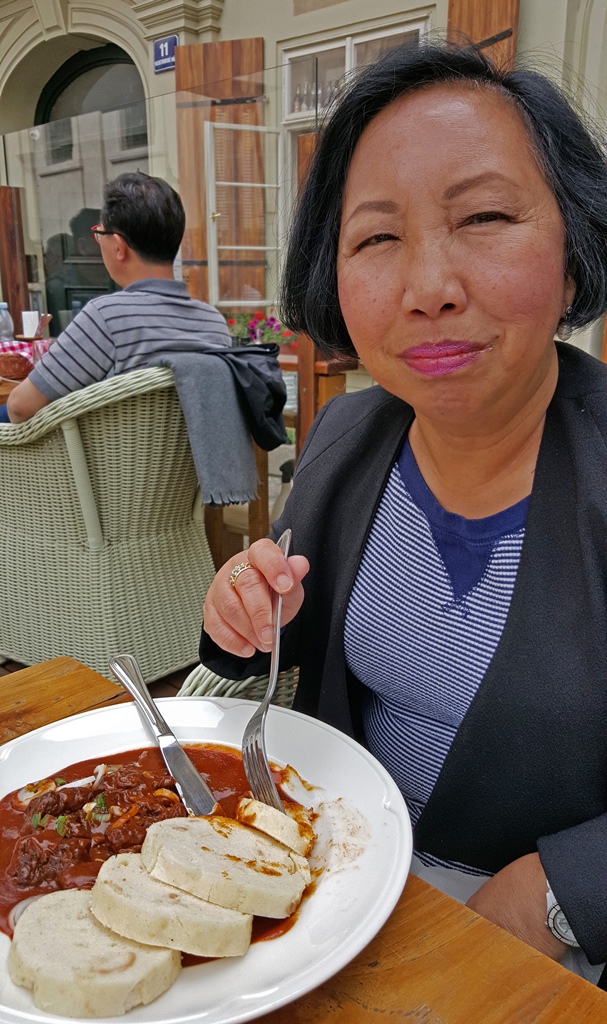Old Town with Charles Bridge (Alois von Saar, 1831)
The Charles Bridge (Karlův Most in Czech) is a stone bridge that crosses the Vltava River
between Prague’s Old Town (on the east side) and Little Quarter (on the west). It’s 1,692
feet long and about 31 feet wide. It’s been restricted to foot traffic only since a repair
project that took place between 1965 and 1978. The bridge is the oldest in Prague by far,
having been built between 1357 and 1402. Since prehistoric times, this part of the Vltava
was routinely crossed using fords, a factor contributing to the founding of the city in this
location. In the early years, at least one wooden bridge was built to cross the river in
this approximate spot. The first stone bridge built here was built between 1158 and 1172 at
the direction of King Vladislav II. This bridge was called the Judith Bridge, named after
Vladislav’s wife. It was located slightly to the north of today’s Charles Bridge, and
served Prague for many years. However, it was destroyed by a flood in 1342, creating a need
for a new bridge. In 1355, the Bohemian King Charles IV became Holy Roman Emperor, a
position that undoubtedly made it easier to command the building of a new bridge. Charles
himself laid the first stone in 1357. The bridge is now named after Charles, though it
wasn’t officially named as such until 1870 (before this it was called “Stone Bridge” or
“Prague Bridge”). The bridge soon became a major crossing point for trade routes in this
part of Europe.
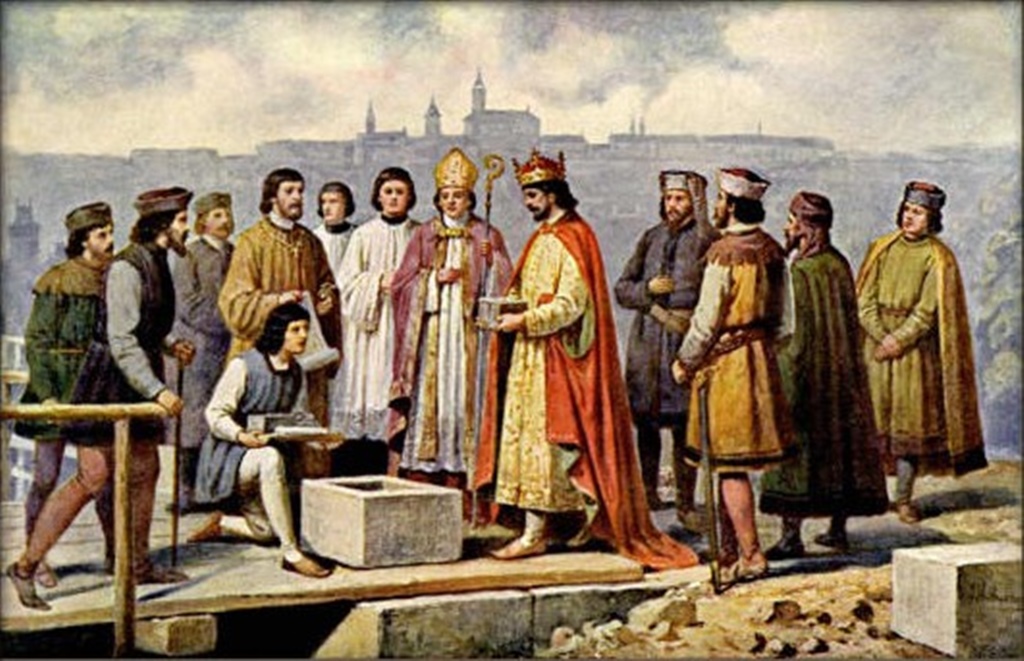
Charles IV Laying First Stone (Josef Mathauser)
The bridge, built mainly of sandstone, has suffered damage on many occasions. One such occasion
happened in 1648, and marked the end of the Thirty Years’ War (if you’ve read
the Prague Castle page, you may remember that
1618’s Defenestration of Prague triggered its start). In summer of 1648, three Swedish armies
targeted Prague, and didn’t have too much trouble occupying its west bank, including Prague
Castle and the Little Quarter. They spent some time looting the treasures they found,
including an art collection belonging to Holy Roman Emperor Rudolf II (much of which remains in
Sweden to this day), but eventually attentions were directed toward the Old Town, on the east
bank. As you can see from the map below, the only way to get to the Old Town was by crossing
the Charles Bridge. By this time the Old Town had put together a defensive force, mainly
composed of students from the University of Prague, and some intense fighting took place on the
bridge during the month of October. On October 24, the Peace of Westphalia was signed, ending
the Thirty Years’ War. But this happened in Westphalia, over in northwestern Germany, so the
combatants in Prague didn’t find out until a week later, during which they continued fighting.
On November 1, when the Swedes found out the war was over, they stopped fighting and eventually
moved on to Sweden, taking their booty with them.
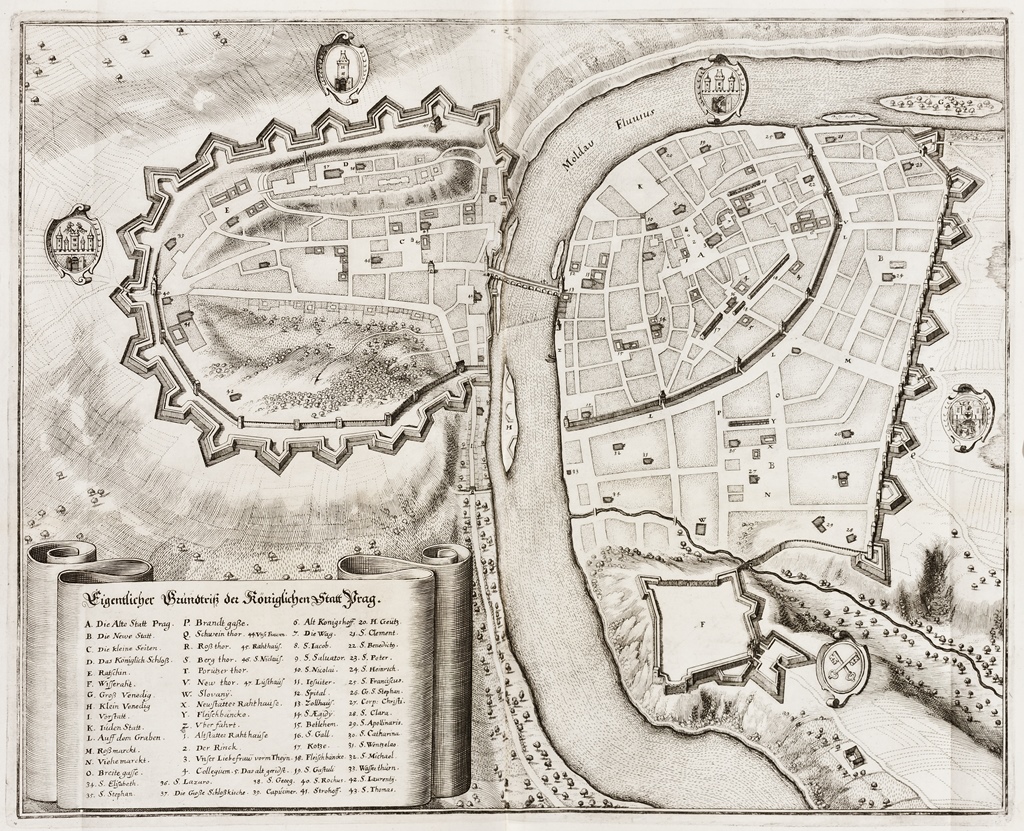
Prague During Swedish Siege, 1648
But damage caused to the Charles Bridge as a result of warfare pales in comparison to damage
wrought by nature. During the centuries when the bridge was the only bridge in the area, there
was always a danger of floating debris getting backed up against it. In the winter, this
debris could take the form of ice floes, which needed to be broken up so they could flow
through the arches under the bridge. But times of flood have been more damaging, as floating
trees and wreckage from upstream was not as easy to break up, and it could pile up into
mountains of flotsam that would cause substantial damage to the bridge. This has happened
several times over the bridge’s life, and wooden structures have been constructed upstream of
the bridge which appear to be designed to break up or redirect these assaults on the bridge’s
integrity. The structures have apparently been effective, as there hasn’t been any massive
damage to the bridge in recent years. Still, structural problems are often discovered, and
bridge renovation to correct them is an ongoing process.
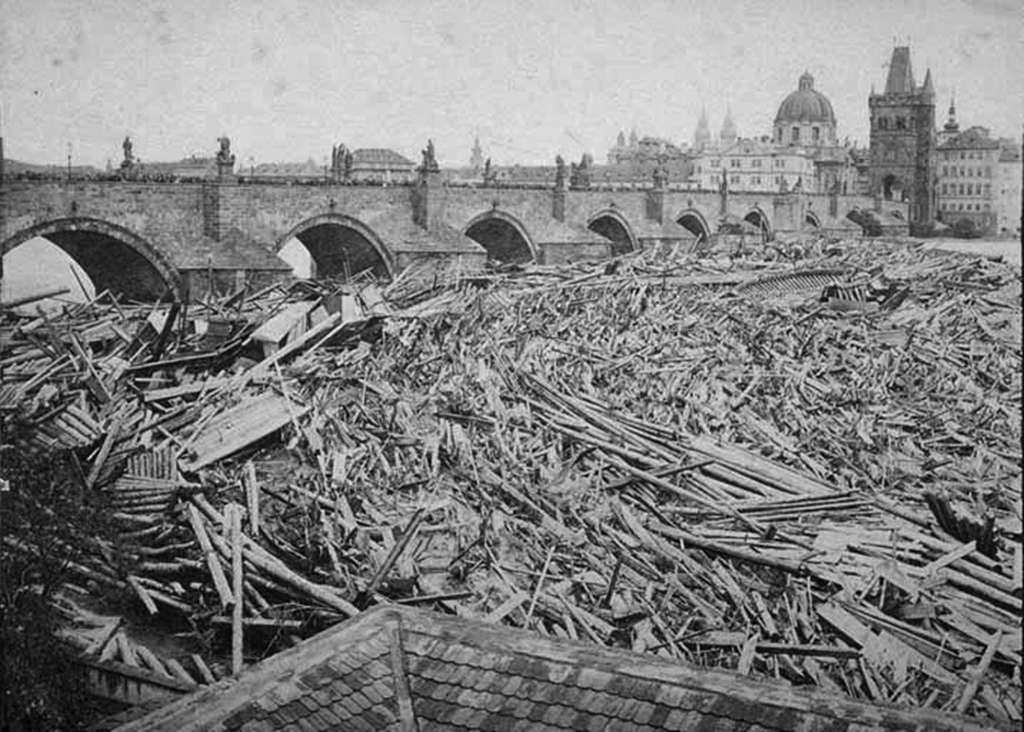
Charles Bridge During Flash Flood, 1872
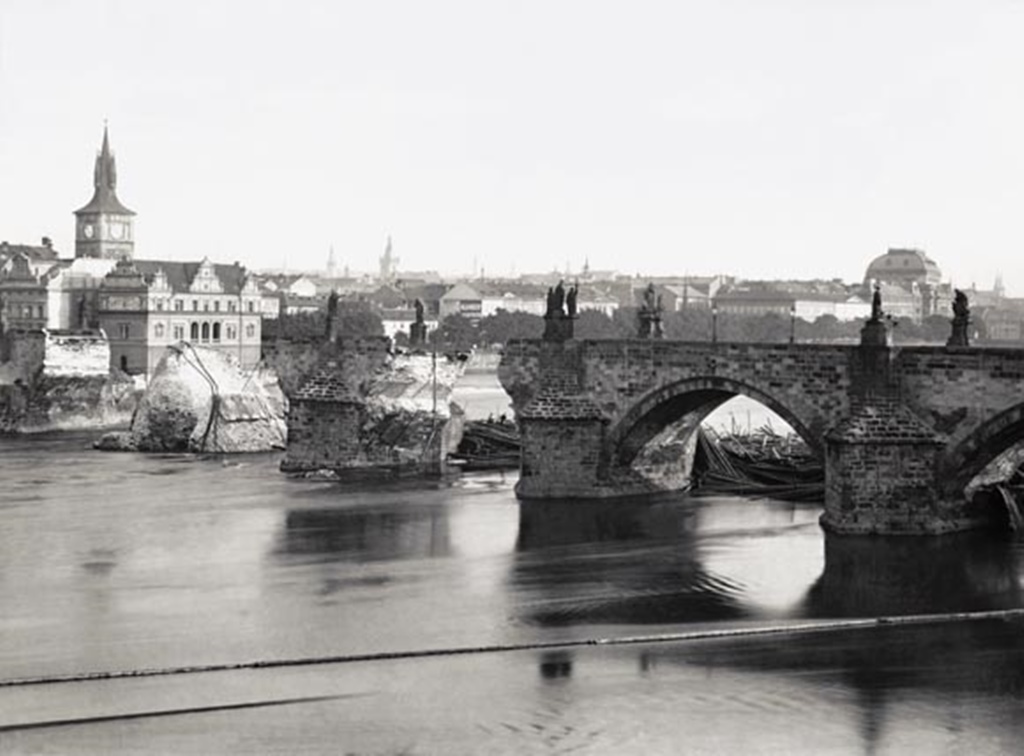
Damage from 1890 Flood
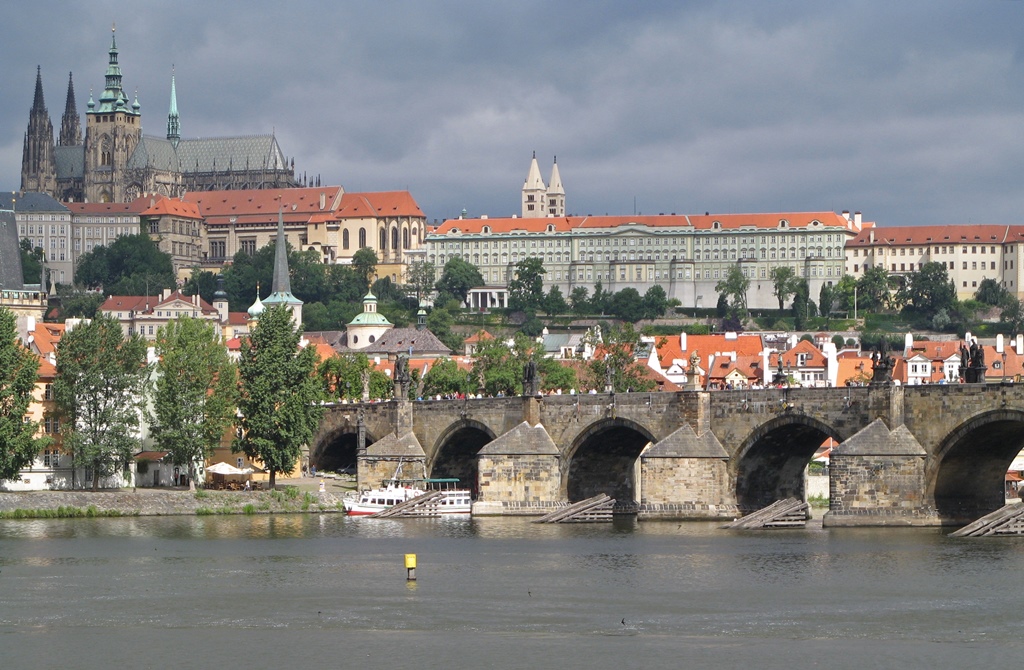
Charles Bridge with "Icebreakers"
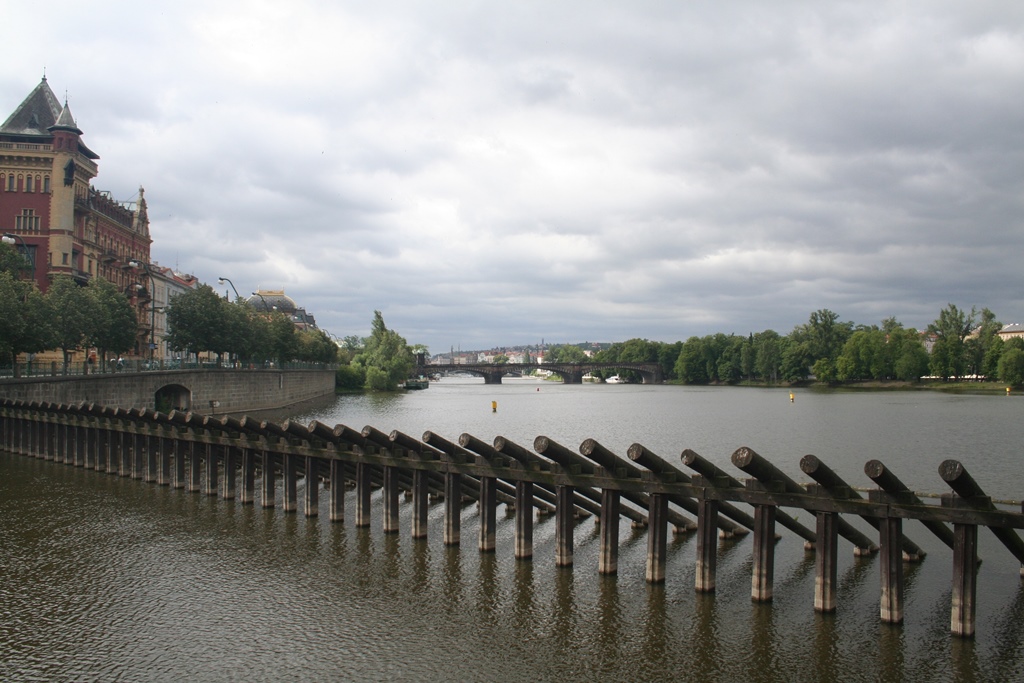
Debris Barrier
When we left off in the last page, we were at the St. James Church, east of Old Town Square.
Getting to the Charles Bridge involved going back through Old Town Square, and then through
a neighborhood which was densely populated by some interesting old buildings.
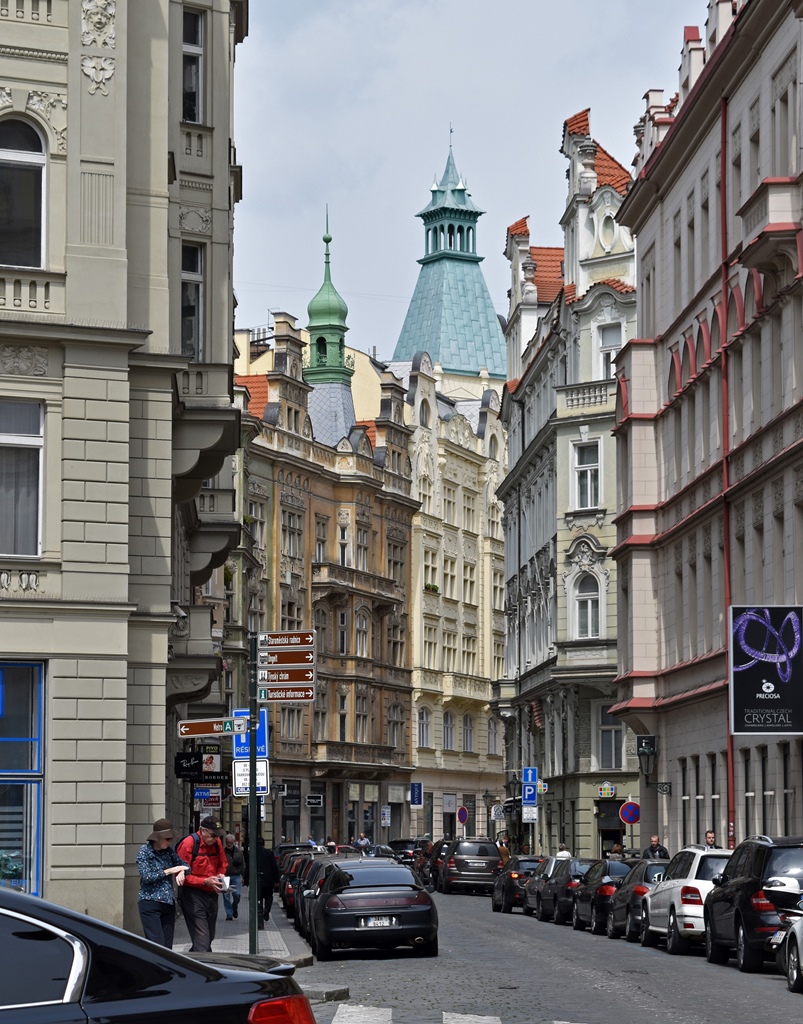
View North on Maiselova
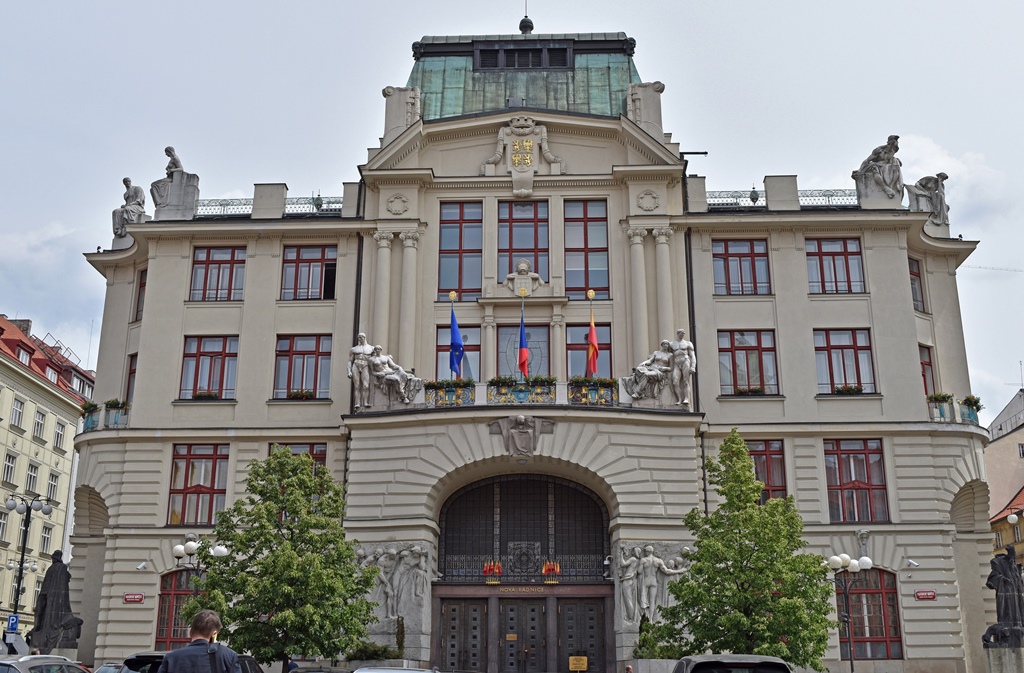
Prague City Hall (built 1908-11)
Emerging from this neighborhood and approaching the bridge, we found this statue of Charles IV.
Statue of Charles IV
At both ends of the bridge there are towers guarding the approaches to the bridge. The
tower at the Old Town end was first built in the 14th Century. If you’ve been reading some
of the earlier Prague pages, you may recall a mass execution in 1621 of several members of
the nobility who led a short-lived rebellion against the Holy Roman Empire (which turned
into the Thirty Years’ War). Following the executions in Old Town Square, the heads of 12
of the leaders were hung from the bridge tower at the Old Town end, as a warning to others
who might get similar ideas (the heads disappeared mysteriously after being on display for
ten years). In 1648, the tower suffered considerable damage in the fighting with the Swedes
described above and had to be extensively repaired. It’s been renovated multiple times
since then and acquired its present appearance in the 19th Century.
Old Town Bridge Tower
We passed through the archway at the base of the tower and found ourselves on the Charles
Bridge. Just upstream from this end of the bridge there was a clump of buildings jutting
out into the river that comprise the Bedřich Smetana Museum. Bedřich Smetana was a 19th
Century composer who some consider the father of Czech music. At a time when German was
the official language in Bohemia, he developed operas in Czech, at the same time that he was
developing a unique musical style (influenced by Liszt and Wagner) that came to be associated
with the region. We were not familiar with his work, so we didn’t visit this museum. Maybe
next time.
Bedřich Smetana Museum
Directing our attention to the bridge itself, we found it to be very crowded with tourists
and vendors of various kinds. Also with positions staked out on the bridge were musicians
providing entertainment for the throngs (and hoping to cell CDs of their music for
reasonable prices).
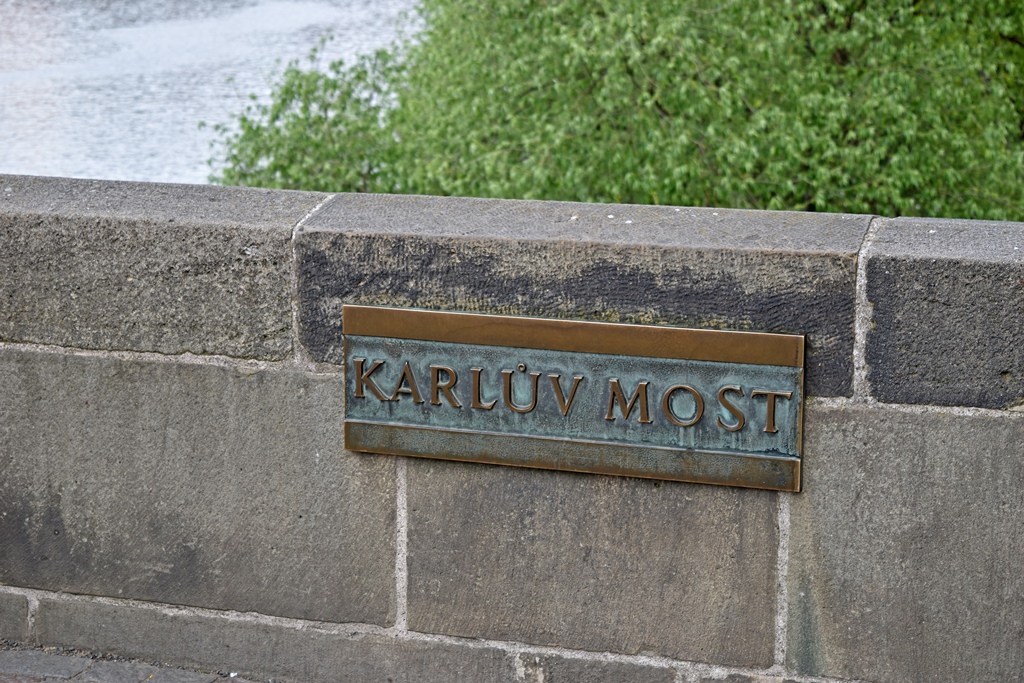
Karlův Most Sign
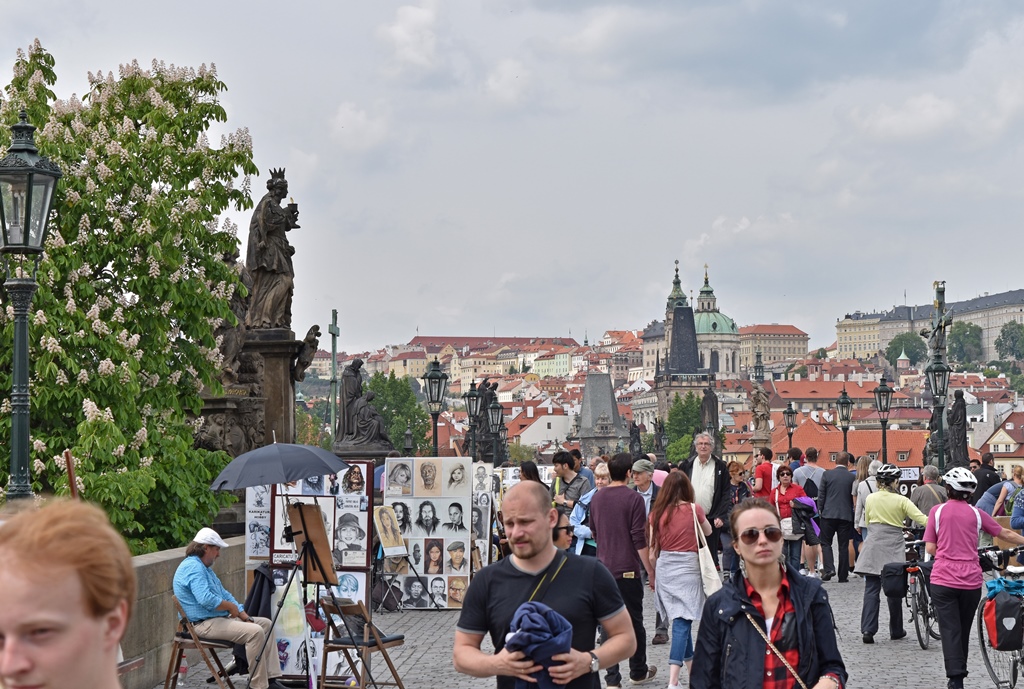
Crowd on Bridge
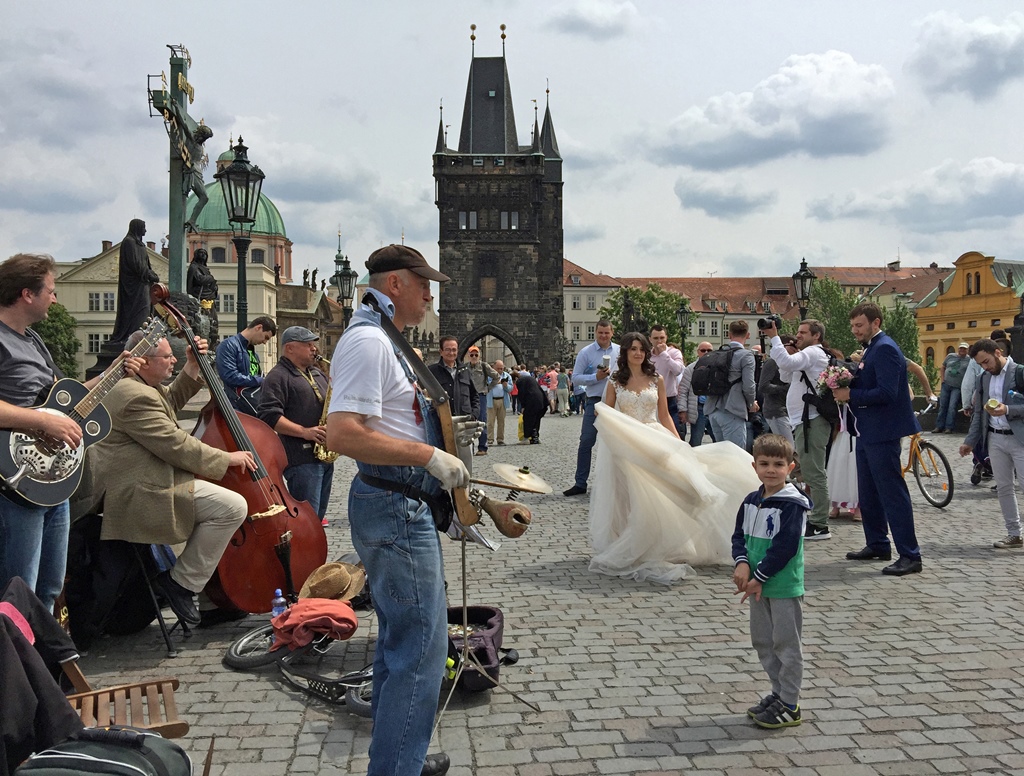
Musicians and Bridal Couple
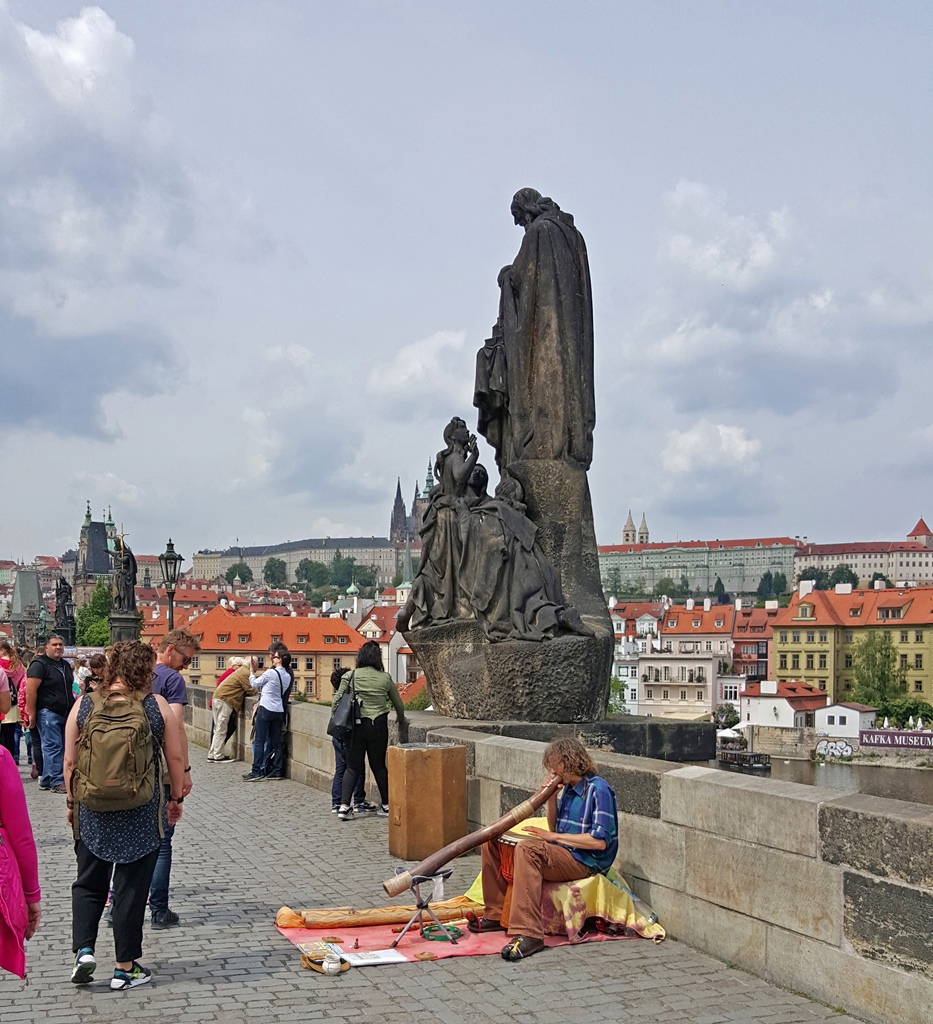
Didgeridoo Player with Statues of Sts. Cyril and Methodius
Finding some areas with a little elbow room, we found that fine views were to be had from the bridge.
Old Town Bridge Tower (Bridge Side)
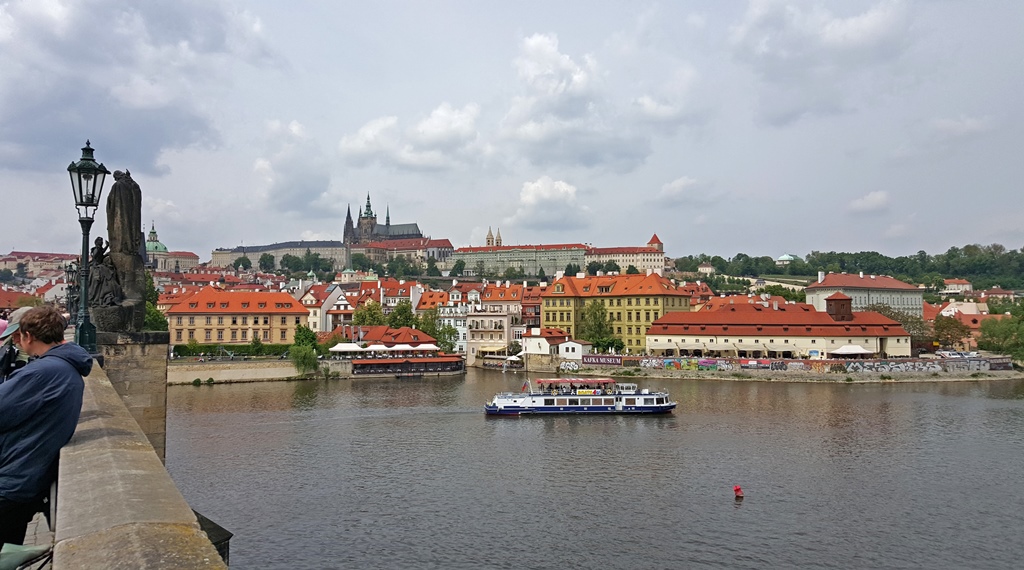
Prague Castle and Tour Boat

St. Vitus Cathedral and Tourists
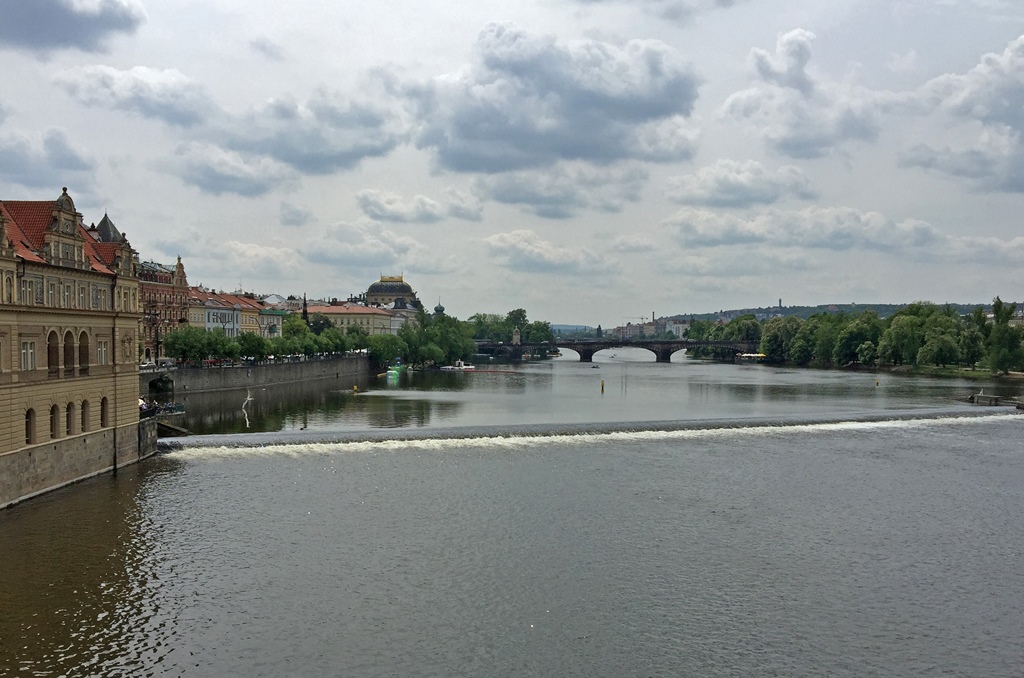
Vltava Upstream from Bridge

Upstream from Bridge
Lining the railings of the bridge are several Baroque statues, mostly of saints. The
original statues were added to the bridge between 1683 and 1714. The ones on the bridge now
are 20th Century copies, with the originals having been moved to the National Museum for
their protection.
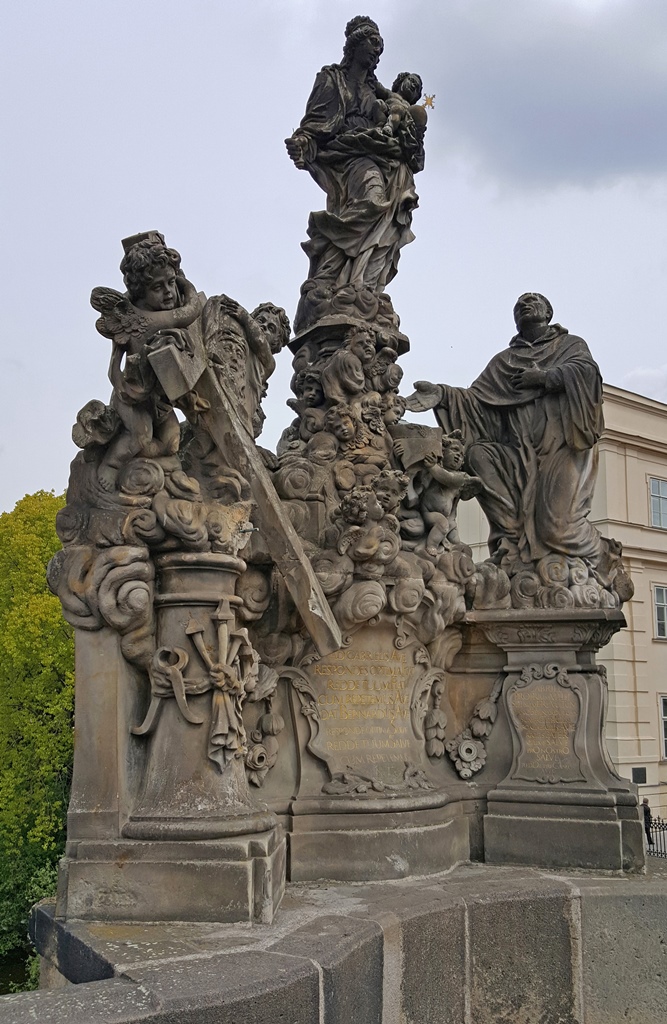
Madonna and St. Bernard (Matej Václav Jäckel)
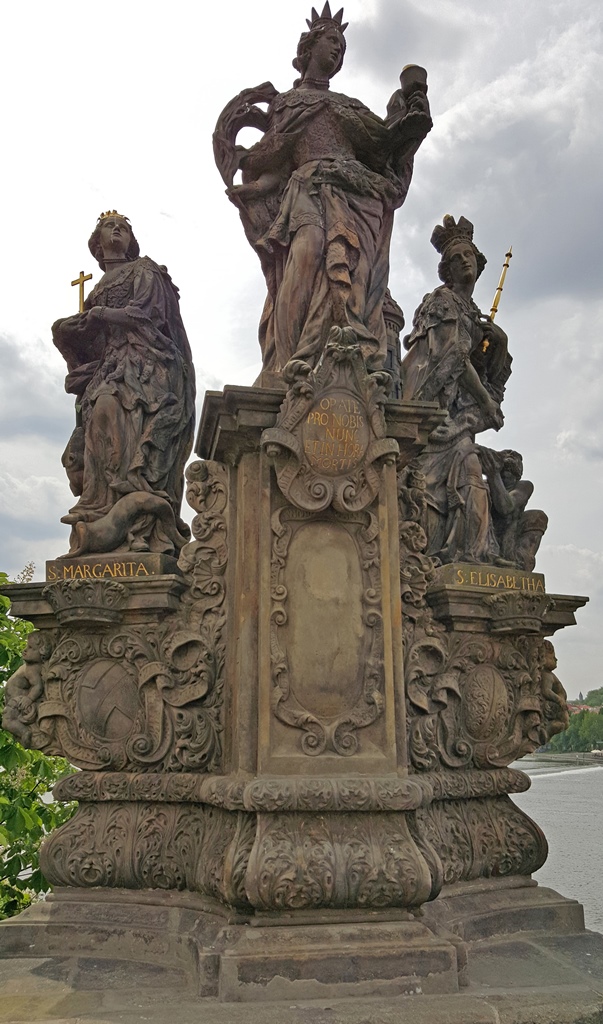
Sts. Barbara, Margaret and Elizabeth (F. Brofoff, J. Brokoff, M. Brokoff)
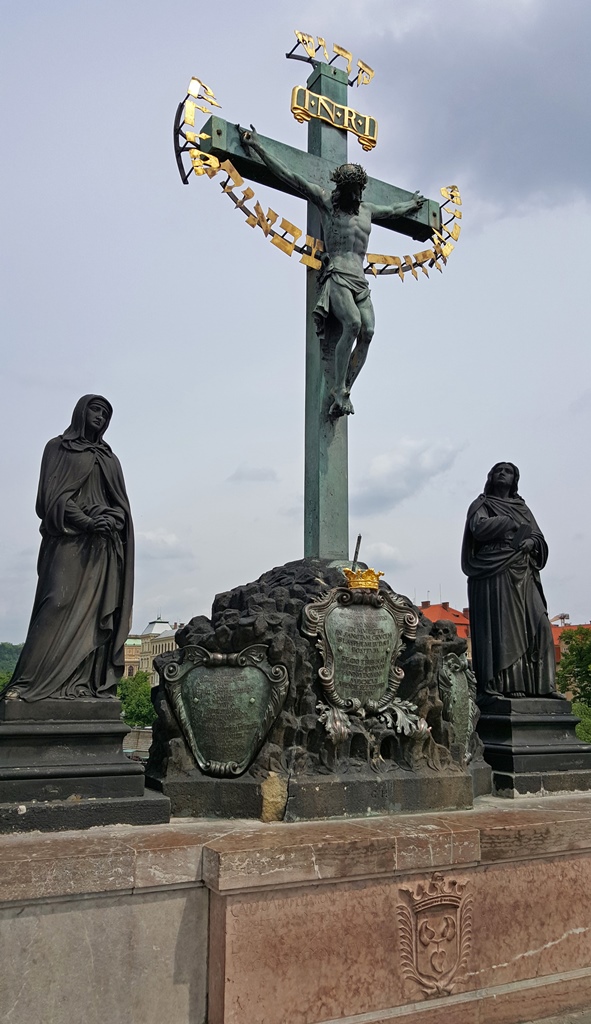
Calvary (Emanuel Max)
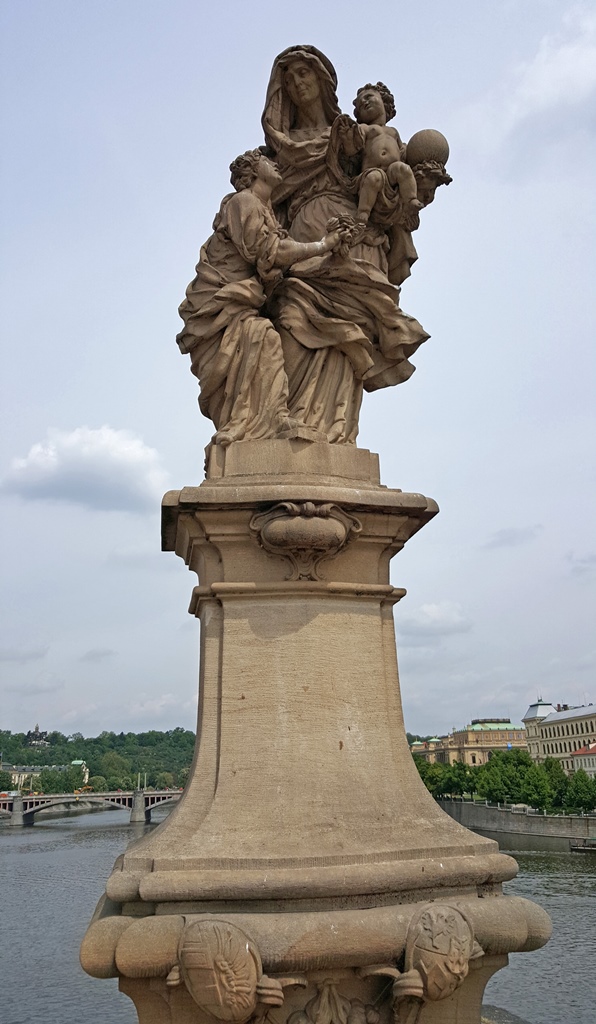
St. Anne (Matej Václav Jäckel)
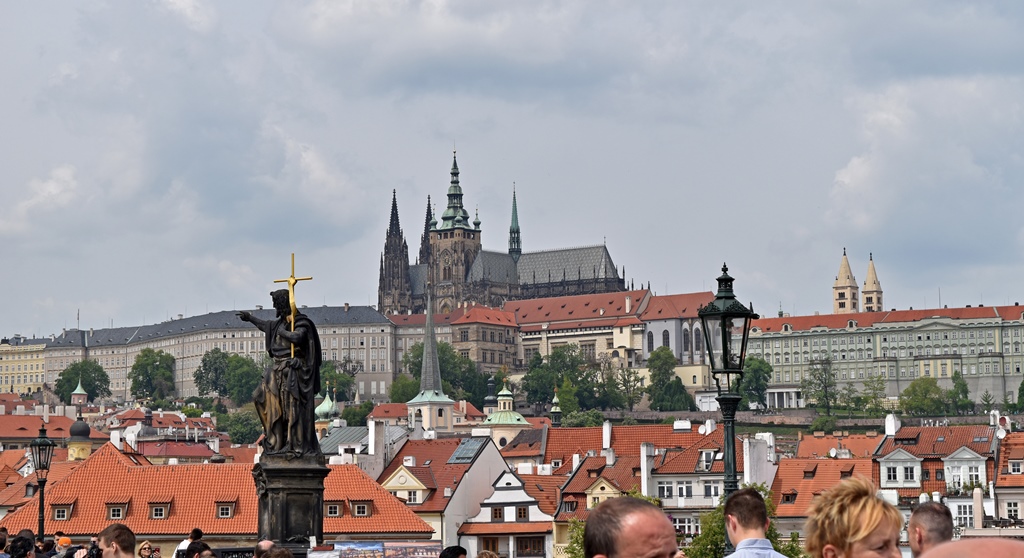
St. Vitus Cathedral and St. John the Baptist
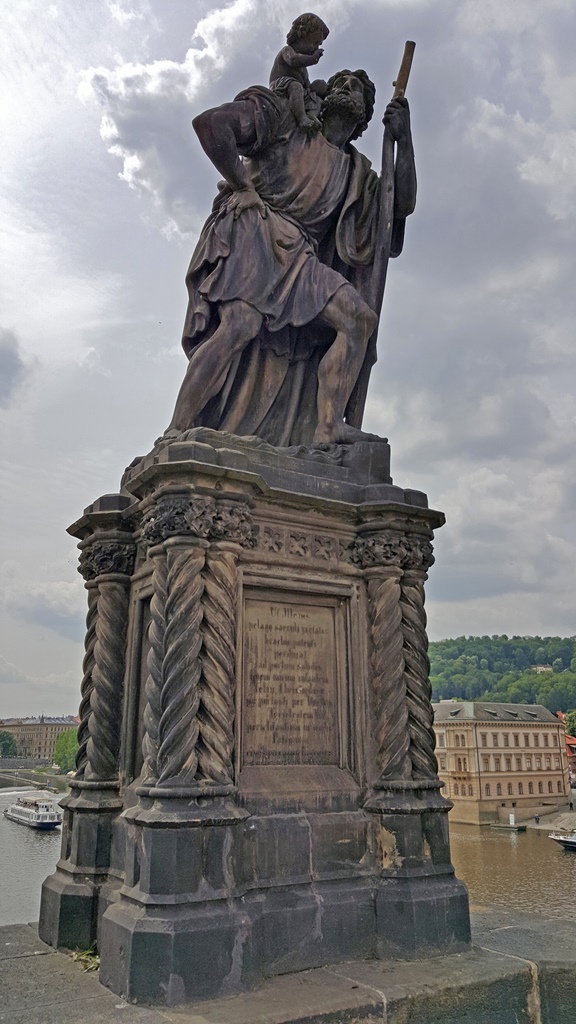
St. Christopher (Emanuel Max)
On approaching the west end of the bridge, we found nice views of the Little Quarter and
Prague Castle.
Little Quarter Bridge Tower and St. Vitus Cathedral
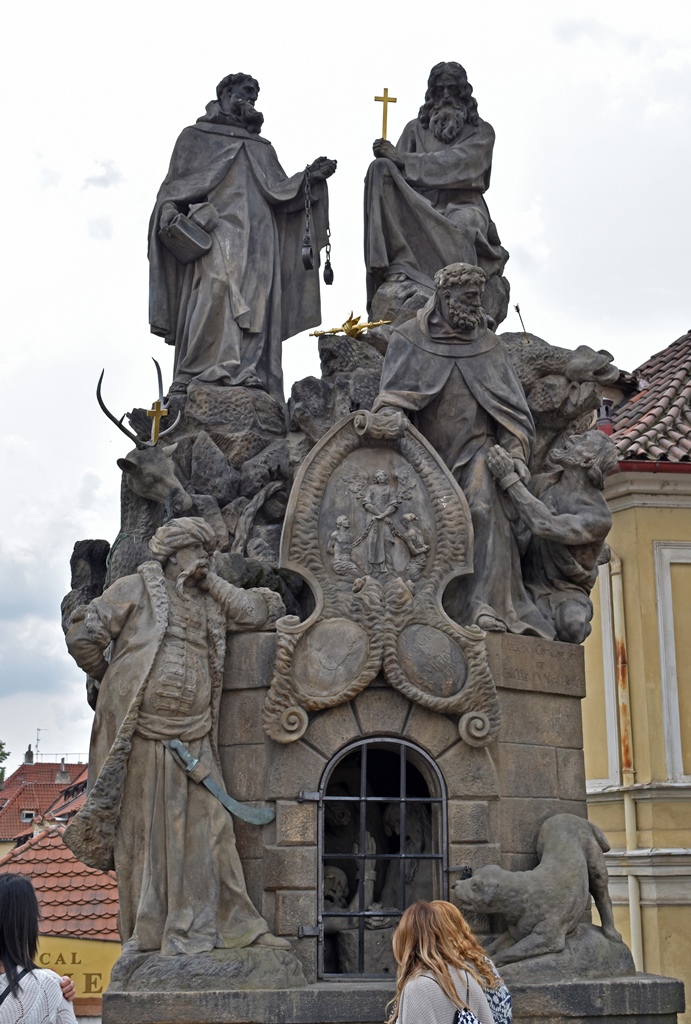
John of Matha, Felix of Valois and St. Ivan (Ferdinand Brokoff)
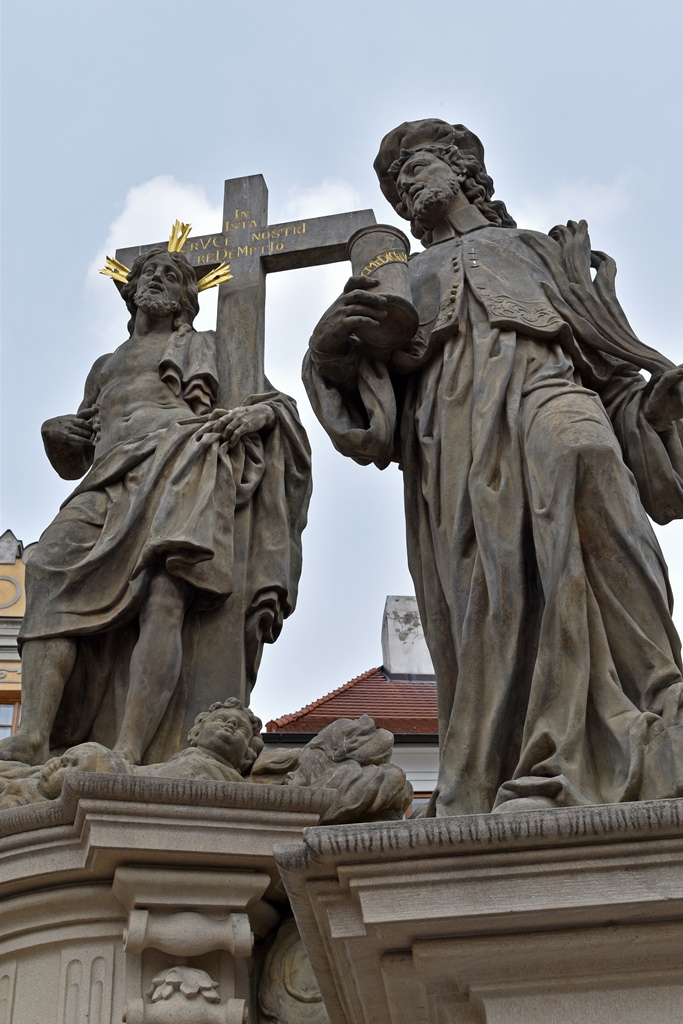
Sts. Cosmas and Damian (Jan Oldrich Mayer)
Among the statues on the bridge are representations of St. John of Nepomuk, a priest who
was thrown from the bridge and drowned in 1393 when he refused to divulge the content of
the confession of the Bohemian queen. St. John is buried in an elaborate tomb in St. Vitus
Cathedral. It’s considered good luck to rub certain parts of bronze reliefs appearing on
some of the statues – these parts are easy to find, as they’ve been worn shiny. I’m not
sure where the good luck is supposed to come from – the saint doesn’t appear to have been
overburdened with it.
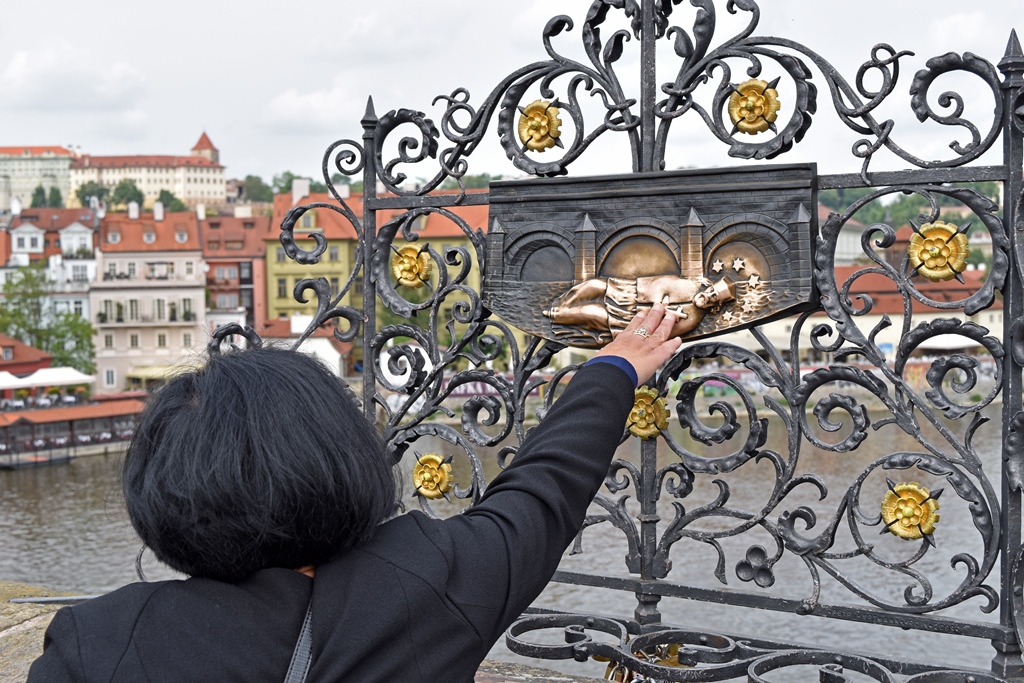
Nella and Bronze Relief of St. John of Nepomuk
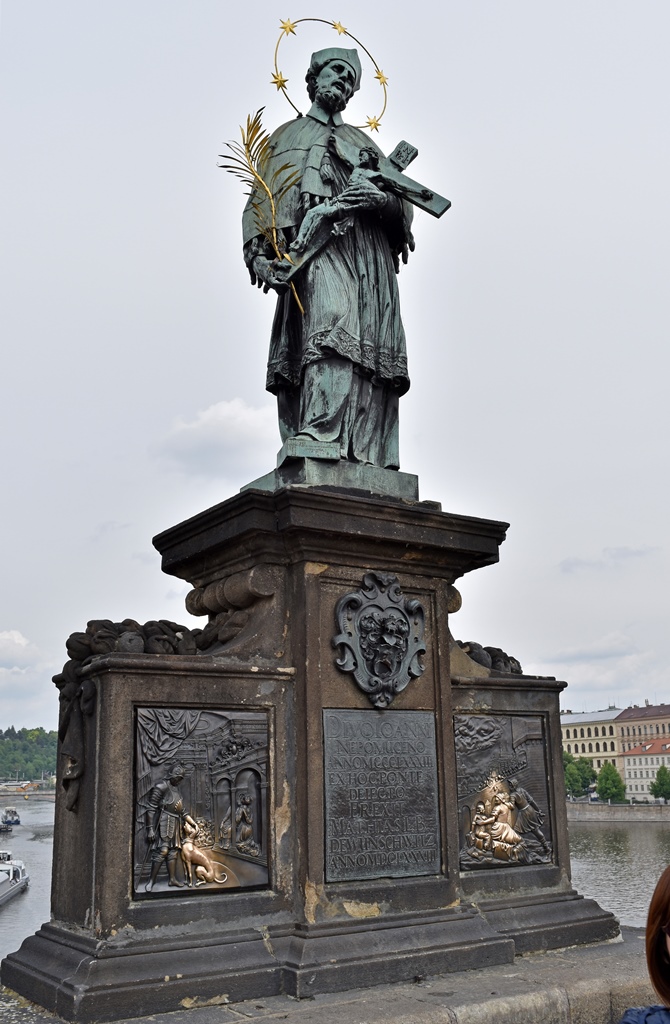
Statue of St. John of Nepomuk (Jan Brokoff)
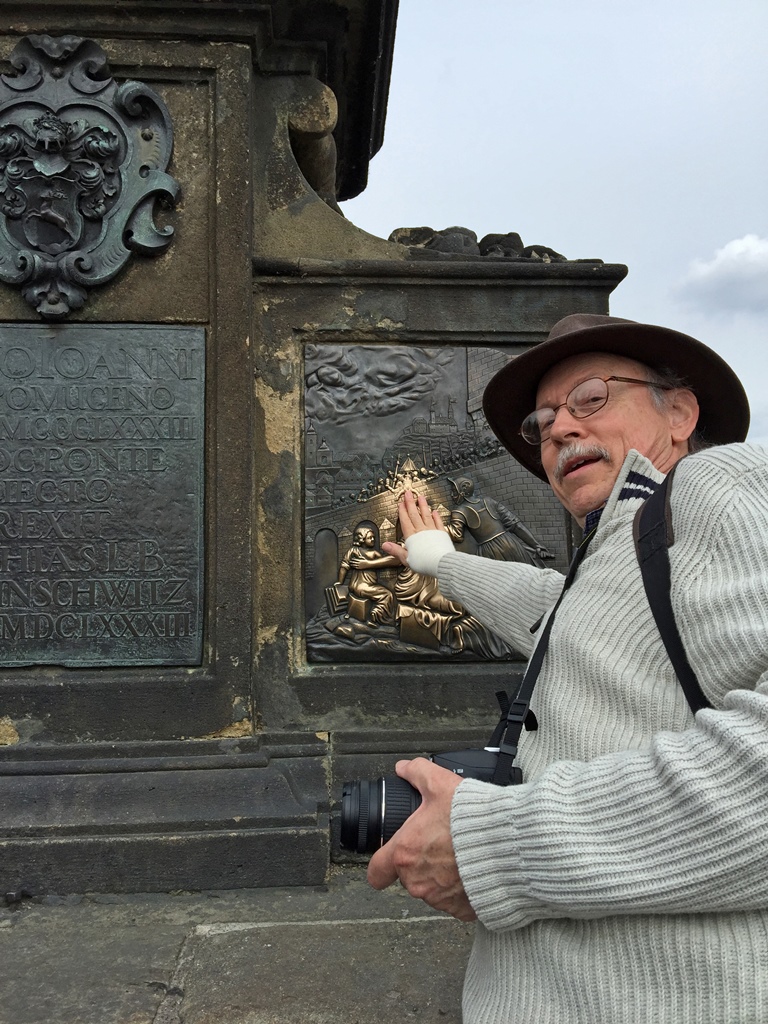
Bob and Relief of St. John of Nepomuk
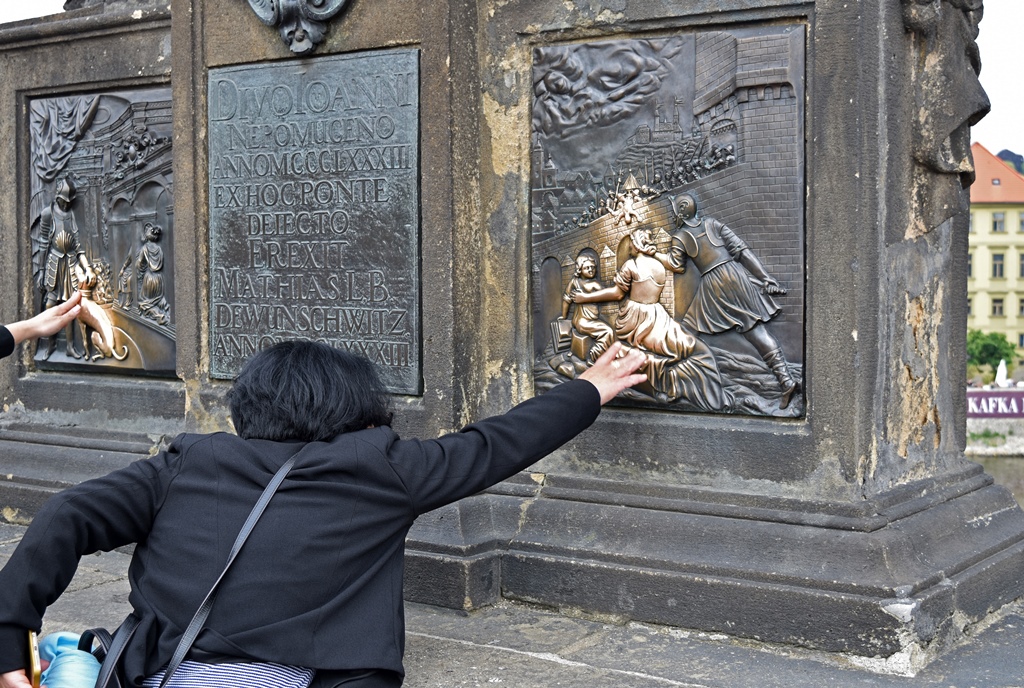
Nella Trying to Reach Relief
The west end of the bridge has a tower of its own (or rather two connected towers, to be
precise). We passed through this tower and entered the Little Quarter.
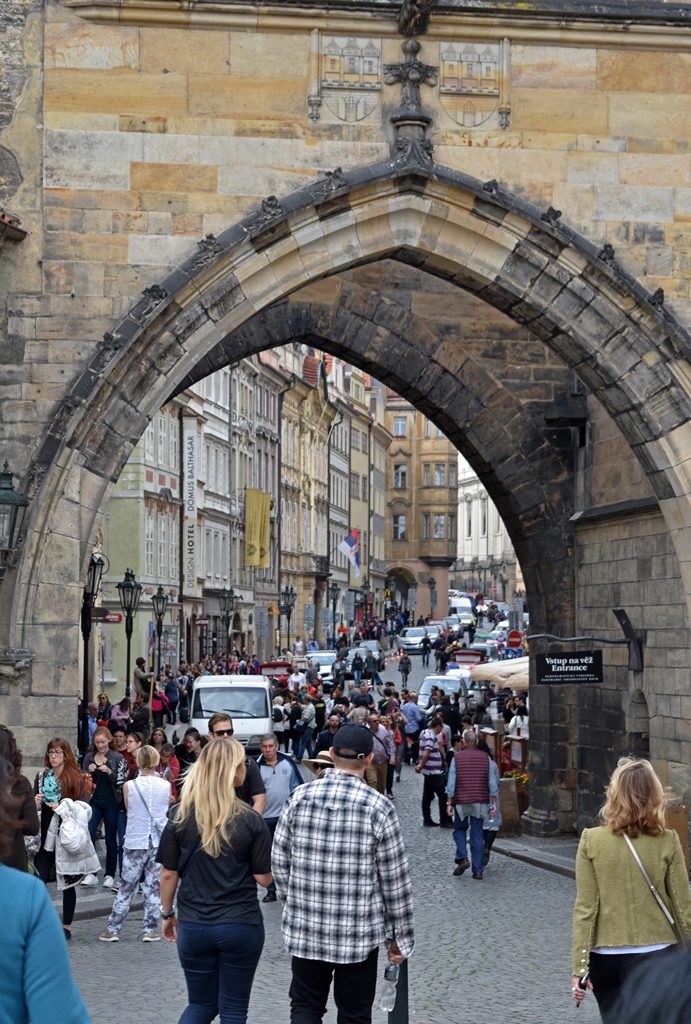
Archway into Little Quarter
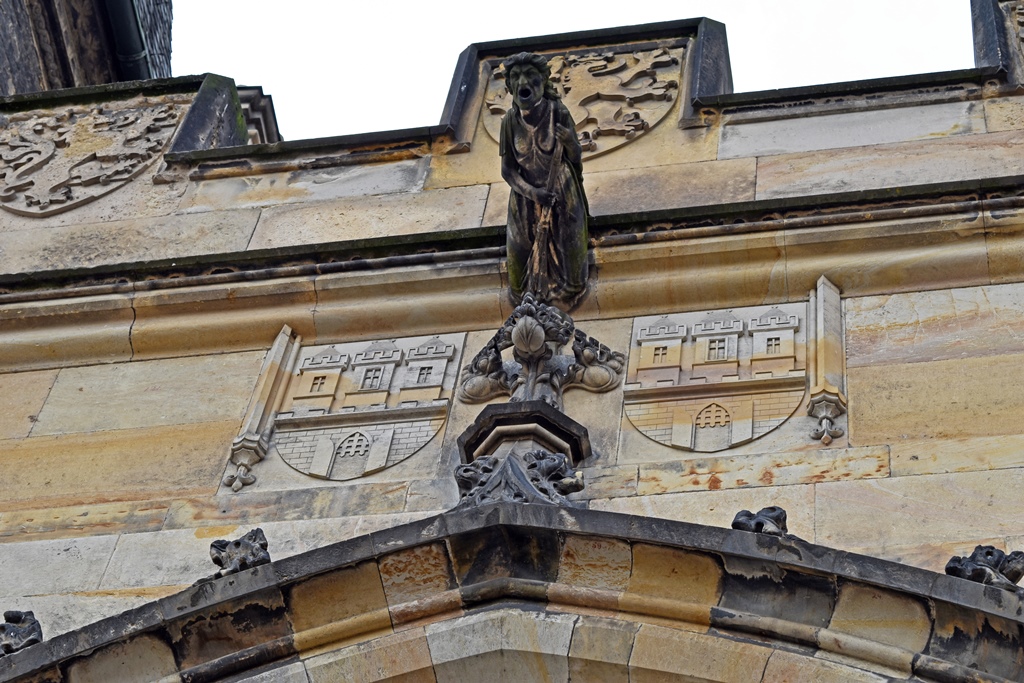
Detail, Little Quarter Bridge Tower
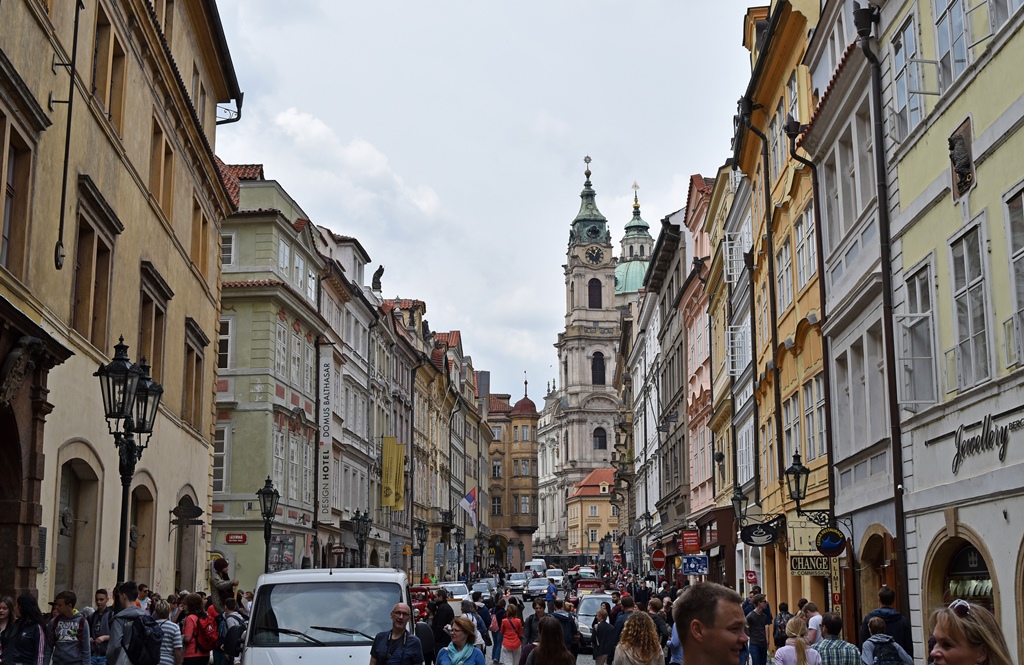
View Along Mostecká, Little Quarter
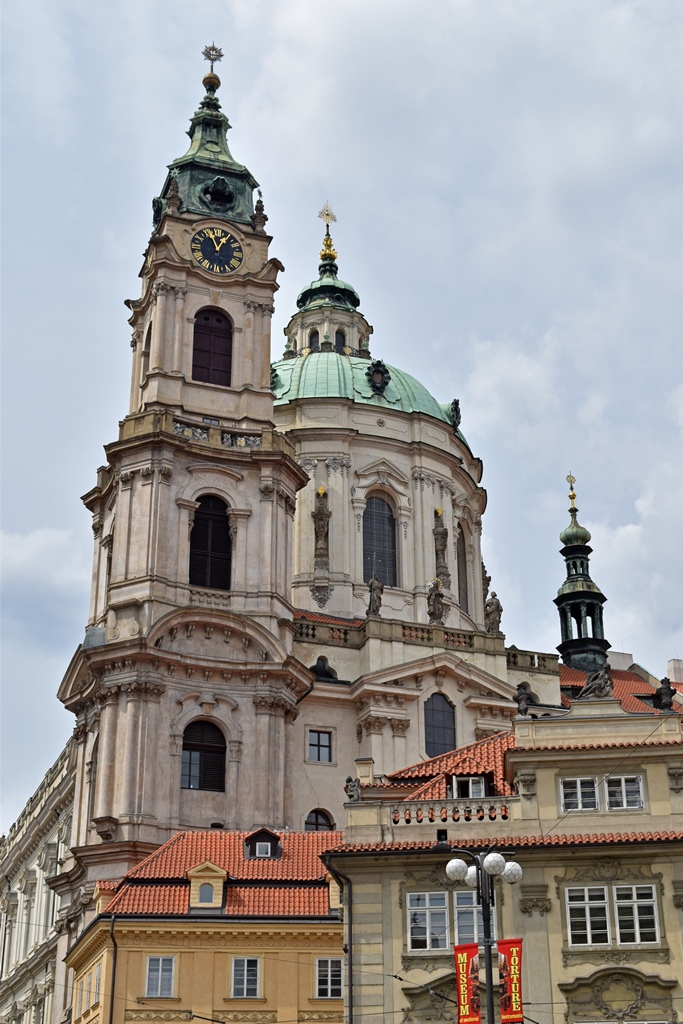
St. Nicholas Church
By this time, we were ready for lunch, and we found a bistro across the street from the St.
Nicholas Church we’d visited the day before. We both ordered a Czech version of goulash.
Nella with Goulash and Bread
From here we returned to our hotel and took a short rest. Or rather I took a short rest,
while Nella took one that was more prolonged. I’d been interested in taking a closer look
at some of the city’s architecture, and I went out for a walk to see what I could find.

